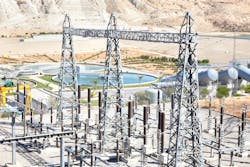Effects of Low Harmonic Drives on Plant Reliability
Understanding potential problems and available solutions
Variable speed drives (VSDs), along with many other types of electronic equipment, can cause a phenomenon known as power line harmonics. The energy efficiency and performance advantages of using VSDs to control pumps and blowers in the water industry far outweigh the negative effects of harmonics. Even so, it is important to understand the potential reliability problems they can cause and the solutions that are available to mitigate their troublesome effects.
Defining Harmonics
In a perfect world, the alternating current (AC) power supplied by the distribution network to the water plant has a pure sinusoidal waveform. This runs at a frequency of either 50 or 60 Hertz (Hz) depending on the region. In the real world, however, voltage and current deviate from this pure waveform due to ‘pollution’ resulting from harmonic frequencies. These harmonics are represented as multiples of the base frequency. It must be noted that harmonics are completely different from radio frequency interference (RFI) disturbances because harmonics are typically at low frequencies, below 3,000 Hz, while RFI is typically above 150 kilohertz (kHz).
To measure the impact of harmonics we usually refer to a percentage value — total harmonic distortion (THD). This is the ratio of the root mean square (RMS) harmonic content over the RMS value of the fundamental frequency. In cases where the voltage or current does not contain any harmonics, the THD is zero percent. As the level of harmonics increases, the THD value increases.
What Causes Harmonics?
Harmonics are created by non-linear loads that do not draw current sinusoidally from the electricity supply. In addition to VSDs, examples of these non-linear loads include LED lighting, computers, uninterruptible power supplies, and the majority of modern electronics that include a separate power supply.
Problems Related to Harmonic Distortion
A water industry installation with high levels of harmonic distortion can experience a wide range of problems. These include:
• Premature failure and reduced lifespan of equipment, especially due to overheating of motors, transformers, cables, circuit breakers and fuses
• Nuisance tripping of breakers and fuses
• Unstable operation of backup generators
• Unstable operation of sensitive electronic devices
• Flickering lights
These issues can have a significant economic impact during all phases of the lifespan of the installation. Initially, there is the cost of either sizing equipment to handle harmonics or investing in harmonic mitigation. System inefficiency results in increased day-to-day running costs, and then there are the repair and replacement costs associated with premature failure of equipment. Loss of water or excess water spills due to unplanned downtime is also a significant cost.
Dealing with Harmonics
A simple approach to dealing with the overheating created by the added harmonic current is to oversize some of the key electrical infrastructure such as transformers and cables. Oversizing of backup generators is also a common way to mitigate some of the challenges, in addition to overheating problems, created by harmonics.
Mitigating VSD Harmonics
The alternative to investing in oversized equipment is to install devices that create less harmonics in the first place. There are a number of ways to mitigate the harmonics produced by VSDs:
Six-Pulse Drive — No Reactor: A standard six-pulse drive without any harmonic mitigation is used because of its lower cost and small footprint. The exact current distortion varies according to the design. Values between 90 and 120 percent are typical.
Six-Pulse Drive — 3–5 Percent Reactor: A standard six-pulse drive with added DC choke or input line AC reactor increases the impedance, which decreases harmonic current levels to between 35 and 45 percent (ABB recommends this as the starting point). If harmonic calculations and surveys indicate that a further reduction in THD is required, then the drive should be upgraded to a better harmonic mitigation technology.
The Importance of Power Factor
Hand in hand with harmonics, it is also important to consider power factor, a term used widely in the electrical industry to describe how effectively an electrical network uses the power it draws. There are in fact three different types of power factor: true power factor, displacement power factor, and distortion power factor.
True power factor takes into account both the displacement power factor (also known as cosφ) and distortion power factor (which is a function of the amount of harmonic current).
It is important for designers and operators of water plants to understand three key things relating to power factor:
• In some cases, utilities will impose penalty charges on customers who have a poor power factor, and/or offer a cost reduction on the utility bills of those who have a good power factor.
• Adding a VSD to a motor will improve the true power factor.
• VSDs that generate fewer harmonics will improve the true power factor better than a VSD with a higher harmonic footprint.
Summary
Handling harmonics is key to plant reliability. It is important for the designers and operators of water industry plants to pay attention to the possible issues that harmonic levels in the power network can create, as the improved reliability and longer equipment life will soon show a return on investment. ULH drives offer a particularly attractive solution as they can mitigate harmonics at source. WW





